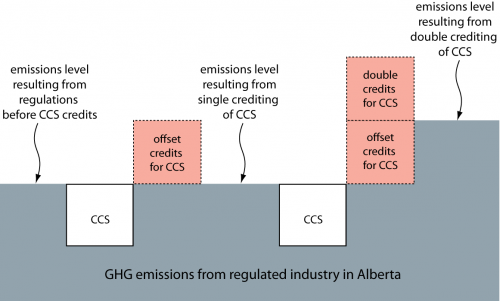Wouldn't it be nice if your loonies turned into toonies overnight? And if they did, don't you think you might end up spending more because of those bonus dollars?
Unfortunately, that's exactly the deal Alberta is now offering to some companies — and the result will be more greenhouse gas pollution.
Here's the situation: the Government of Alberta, along with many companies, wants to support carbon capture and storage. This technology, known as CCS, would see companies capture their greenhouse gas emissions and store them deep underground, rather than allowing them to escape into the atmosphere where they contribute to global warming.
Alberta is counting on CCS to deliver 70 per cent of the emission reductions it needs to hit its 2050 emission reduction target. The problem is that most applications of CCS cost well over $100/tonne, while Alberta's government is charging companies a maximum of $15/tonne for their greenhouse gas pollution.
In its first attempt to close the gap, back in 2008, the province committed $2 billion in public subsidies to support CCS projects. Today, it added a second incentive: giving companies bonus offset credits for every tonne of pollution they reduce using certain CCS projects. These will initially be given out at a two-for-one rate (i.e. two credits for every tonne sequestered), which will decline if a national carbon price is introduced.
Understanding Alberta's offset system
An offset is an emission reduction that takes place outside of the mandatory targets companies have to hit under Alberta's specified gas emitters regulation. Companies are allowed to buy offset credits as a replacement for improving the environmental performance in their own operations. But that exchange only works if the offset credit actually represents an emission reduction: a tonne of pollution from an upgrader needs to be cancelled out by a real tonne of reduction at, for example, a wind farm in southern Alberta.
The government's proposal of two-for-one offset credits gives some companies that want to do CCS a financial bonus, which makes it easier for those companies to invest in the technology. But it also introduces offset credits into the system that are not tied to any actual reductions. Companies will then use those credits to pollute more.
In the process, these artificial offsets will cancel out the emission reduction benefit of doing CCS in the first place.
With bonus credits allowed into the offset system, CCS technology allows emissions under Alberta's emission regulation to increase.
Figure 1 shows how this works. If you reward every tonne of greenhouse gas pollution reduced with one offset credit, you don't increase total emissions. But if you reward companies two credits for every one tonne of reduction, those imaginary credits will be bought by other companies so that they don't have to reduce their own emissions. The net result is that overall emissions go up. If companies buy all the two-for-one offsets available, Alberta's greenhouse gas pollution will rise by one tonne for every tonne that CCS reduces.
That's exactly the opposite of what CCS is supposed to accomplish.
Pembina has been raising questions about the credibility of many Alberta offsets for years. By creating a class of credits that is not based on real emission reductions, today's announcement weakens a system that already needed strengthening.
Better options are available
Perhaps the most frustrating part of Alberta's decision is that it didn't have to be this way. The government had much simpler and greener options available to reach the same goal.
Rather than watering down the offset system, Alberta could have simply increased its price on emissions. The two-for-one offset bonus gives companies about $15/tonne of extra revenue for CCS. Instead of granting imaginary offset credits, why not just increase the price that all companies pay from its current low level of $15/tonne to $30/tonne?
That step would have helped make CCS more economically viable, but it would also send a signal that would encourage other companies across Alberta to cut their own emissions, even if CCS isn't part of the equation for them.
Economic analysis shows that Alberta won't hit its 2050 emission reduction target without a much higher price on pollution than companies pay today (a price of over $100/tonne). So increasing the carbon price in Alberta is a step that needs to happen anyway.
Alberta's companies have continued to prosper under the current price, which represents only a tiny increase in costs for most industries, so there's no need to fear the effects of a higher one. In fact, in a report released earlier this year, the National Round Table on the Environment and the Economy showed that Canada would see strong economic growth across the country even if we lead the United States in adopting a broad-based price on greenhouse gas pollution.
A second important step would be to make CCS mandatory for new facilities in Alberta right away (including major expansions or retrofits that extend the life of existing facilities), and over time to require it at existing facilities as well. Companies in the oilsands, chemical and power generation sectors have huge potential for CCS; a regulation would make sure that potential is realized.
And if the Government of Alberta wanted to get creative, those two policies are only the beginning. In 2008, Pembina worked with Dr. David Keith from the University of Calgary to map out policy choices to close the CCS "cost gap". Some of the proposals that research generated included carbon taxes and cap-and-trade systems, but also tax credits, loan guarantees and public ownership of CCS infrastructure. Bonus offset credits was on the list as well.
We tested that list of choices with a group of Alberta experts. Interestingly, the group rejected the bonus credit option that Alberta's government announced today (see page 18 of this report), citing its administrative complexity and unfair distribution of costs. As the group pointed out, why should one technology receive multiple credits over another?
It's a very good question. But Alberta has placed some important limits on the bonus credit system. They would not apply to coal burning plants or enhanced oil recovery schemes. The bonus credits will be issued for no more than 10 years and, once issued, would only be valid for three years. In theory, fewer bonus credits would be issued if the price of carbon increases.
CCS has a role to play
Our concern about today's announcement may give the impression that we're opposed to CCS — we're not.
If it's used under the right conditions, we believe that CCS technology has the potential to reduce emissions significantly, although it will always be just one part of a portfolio of solutions.
We also understand some of the non-environmental benefits of deploying CCS in Alberta — benefits like creating some jobs and developing expertise in a technology that will be in demand around the world.
But none of that should come at the cost of increasing emissions. Supporting CCS doesn't have to mean adopting flawed accounting based on "reductions" that exist on paper only, not in reality. Alberta's government had a range of options to choose from to support this technology, but today's announcement shows that it made the wrong choice.








